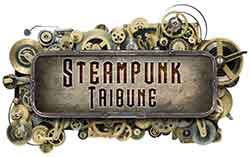Steampunk is a subculture that has gained popularity in recent years. It is a genre of science fiction that is set in a world where steam power is still the primary source of energy. The aesthetic of steampunk is heavily influenced by the Victorian era, and it often features fantastical inventions and designs.
The term “steampunk” was first coined by K.W. Jeter in 1987. Jeter was a science fiction author who was looking for a way to describe the type of fiction that he and his contemporaries were writing. He wanted a term that would capture the essence of the genre, and he settled on “steampunk” because it sounded catchy and evocative.
The origins of steampunk can be traced back to the works of authors like Jules Verne and H.G. Wells, who wrote about fantastical machines and inventions in their novels. The aesthetic of steampunk draws heavily from the Victorian era, which was a time of great technological advancement and innovation. Today, steampunk has become a movement that encompasses not just literature, but also fashion, art, and design.
Origins of Steampunk
The Victorian Era
The term “steampunk” is a relatively new one, but the genre has its roots in the Victorian era. This was a time of great technological advancement, with the Industrial Revolution in full swing and steam power being used to drive machines and transport people and goods. The Victorian era also saw the rise of science fiction, with authors like H.G. Wells and Jules Verne imagining fantastical machines and exploring the possibilities of time travel and space travel.
Literature
The first use of the term “steampunk” is often credited to science fiction author K.W. Jeter, who used it in a letter to Locus magazine in 1987. Jeter was writing in response to a growing trend in science fiction and fantasy literature that he felt was being overlooked. This trend, which he called “steampunk,” was characterized by stories set in a Victorian-era world where steam power was still the dominant technology, and where science and magic were often intertwined.
One of the earliest examples of steampunk literature is “The Difference Engine” by William Gibson and Bruce Sterling, which was published in 1990. This novel imagines a world where Charles Babbage’s mechanical computer, the Difference Engine, was successfully built in the 19th century, leading to a very different technological and political landscape than the one we know today. Other notable works of steampunk literature include Tim Powers’ “The Anubis Gates” and “Morlock Night,” and the “Leviathan” trilogy by Scott Westerfeld.
Conventions and Costumes
Steampunk has become a popular subculture, with fans gathering at conventions and events to celebrate all things Victorian and steam-powered. These events often feature elaborate costumes, with attendees dressing up as characters from steampunk literature or creating their own unique steampunk-inspired outfits. Steampunk conventions are also a place for fans to showcase their own steampunk creations, from airships and gadgets to jewelry and clothing.
Video Games
Steampunk has also made its way into the world of video games, with titles like “Dishonored” and “Bioshock Infinite” featuring steampunk-inspired settings and technology. These games often combine elements of sci-fi and fantasy with the aesthetics of the Industrial Revolution, creating a unique and immersive world for players to explore.
Online and Etsy
The internet has played a significant role in the growth of the steampunk subculture, with online communities and marketplaces like Etsy providing a platform for fans to connect and buy and sell steampunk-inspired goods. YouTube is also home to a wealth of steampunk content, from tutorials on how to create your own steampunk costume to music videos featuring steampunk-inspired bands.
In conclusion, while the term “steampunk” may be relatively new, the genre has its roots in the Victorian era and the science fiction literature that followed. Today, steampunk has become a popular subculture with its own conventions, costumes, and even video games. As technology continues to advance, it will be interesting to see how steampunk continues to evolve and inspire new generations of fans.
Steampunk Goes Mainstream
As the steampunk subculture continued to grow and gain popularity, it inevitably made its way into mainstream pop culture. This section will explore some of the ways that steampunk has become a part of the mainstream, including its influence on fashion and pop culture.
Pop Culture
One of the earliest examples of steampunk in pop culture was the 1999 film “Wild Wild West,” which featured a steampunk-inspired setting and gadgets. While the film was not well-received critically, it did help to bring the aesthetic to a wider audience.
Since then, steampunk has appeared in a variety of media, including television shows like “Warehouse 13” and “Doctor Who,” video games like “Bioshock Infinite” and “Thief,” and even anime like “Fullmetal Alchemist.” Perhaps most notably, the 2004 film “Van Helsing” featured a steampunk-inspired version of Dracula’s castle.
Fashion
Steampunk fashion has also made its way into the mainstream, with elements like corsets, top hats, and goggles appearing in mainstream fashion lines. This trend has been particularly popular in Japan, where it has been embraced by the “Harajuku” fashion scene.
In addition to fashion, steampunk-inspired jewelry and accessories have also become popular, with items like pocket watches, mechanical gears, and clockwork designs appearing in mainstream stores.
Overall, while steampunk may have started as a niche subculture, it has since become a part of mainstream pop culture and fashion. Its influence can be seen in a variety of media, and its aesthetic has become a popular choice for fashion designers and enthusiasts alike.
DIY and Steampunk Culture
Steampunk culture is closely tied to the DIY (Do-It-Yourself) movement, which emphasizes self-sufficiency and creativity. DIY and Steampunk culture have a long history together, as many Steampunk enthusiasts enjoy creating their own gadgets, costumes, and accessories.
Crafting
One of the hallmarks of Steampunk culture is the emphasis on crafting. Steampunk enthusiasts often create their own costumes, accessories, and gadgets, using a variety of materials and techniques. Some popular crafting techniques include sewing, leatherworking, metalworking, and woodworking.
Many Steampunk enthusiasts also enjoy repurposing old objects and machinery to create new and unique creations. For example, an old pocket watch might be transformed into a Steampunk-style wristwatch, or an old typewriter might be turned into a working USB keyboard.
Community
The Steampunk community is also closely tied to the DIY movement. Many Steampunk enthusiasts enjoy sharing their creations with others, and there are numerous Steampunk forums, websites, and social media groups where enthusiasts can share their work and connect with others who share their interests.
In addition, many Steampunk events and conventions feature workshops and classes where enthusiasts can learn new crafting techniques and share their knowledge with others. These events also provide an opportunity for Steampunk enthusiasts to showcase their creations and connect with others who share their passion for the Steampunk aesthetic.
Overall, the DIY ethos is an integral part of Steampunk culture, emphasizing creativity, self-expression, and self-sufficiency. By creating their own gadgets, costumes, and accessories, Steampunk enthusiasts are able to express their individuality and connect with others who share their interests.




